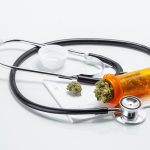Just weeks before recreational pot becomes legal in California, San Francisco public health officials have published a report on their best guesses for problems that could arise from widespread marijuana use, including abuse of the drug by young people and unforeseen health risks among adults.
The challenge, authors of the report noted, will be warning new users about the hazards of cannabis consumption — like the possibility of overdosing or driving under the influence — without straying into fearmongering.
The report takes no stand for or against legalization, which was adopted by California voters in November 2016. Because legalization is still a relatively new phenomenon in the United States, though, it’s not yet clear what public health issues might arise, officials said. The report, therefore, stands as a sort of benchmark.
“Legalization is in an infancy stage,” said Israel Nieves, director of the Public Health Department’s Office of Equity and Quality Improvement, which compiled the cannabis report. “There’s been a lot of work done around medicinal use, but not recreational. We need to prepare ourselves.”
The five-page executive summary of the report was published online earlier this month. The full report is expected before the end of the year. The summary includes six recommendations, mostly around education and community outreach.
The report also discusses public health hazards associated with clustering pot dispensaries in certain neighborhoods; already, medical marijuana shops are largely located in lower-income areas with more black, Asian and Latino residents. But in interviews, public health officials said they make no recommendations on the issue and are leaving decisions about where dispensaries should be allowed to policymakers.
The San Francisco Board of Supervisors has been debating for several weeks how to best distribute permits to sell recreational marijuana. The issue is so contentious that it seems unlikely the board will reach a consensus before the state law legalizing recreational pot use takes effect Jan. 1.
Drug and public health experts praised the report, but some said it’s not strong enough in warning of possible hazards of regular marijuana consumption, including addiction.
“We need to be more concerned about adult use,” said Keith Humphreys, a Stanford addiction expert who served on the state’s Blue Ribbon Commission on Marijuana Policy, which helped shape the legalization legislation approved by voters. “How we think about it at the moment — and this report shows that thinking — is it’s bad for kids, but for adults it’s safe. And we need to start thinking about it like we do alcohol, which is it’s bad for kids, but there are adults who do damage to their lives with this drug too.”
Public health officials began compiling the report about six months ago. They based their recommendations on studies done in states where recreational marijuana is already legal, as well as a focus group meeting with San Francisco teenagers and interviews with doctors, drug-use experts and cannabis representatives.
An overarching concern, public health officials said, is that legalization may be seen as an endorsement and gives the impression that consuming marijuana is largely risk-free. That message could be especially problematic for young people, who may not realize that cannabis can impact brain development and cause other health issues, Nieves said.
He added that public health officials are not interested in scare tactics like those used during the “just say no” campaigns of the 1980s and ’90s. But there are negative effects potential users — teens and adults — should be made aware of, he said.
Already, as laws have loosened around cannabis use and more people are using it — and as the drug itself has become more potent — hospital and emergency room visits related to cannabis have increased. The report notes that in San Francisco, visits for cannabis-linked problems were roughly double for the five-year period 2011-15 compared with 2006-10, though the overall numbers are still low. In the earlier years, there were 133 total ER visits, compared with 251 in the later years. Hospitalizations increased from 21 to 52.
Edible cannabis products are of particular concern because it’s easy to eat too much of them, Nieves said. The report recommends San Francisco adopt strong regulation of edibles and make sure that advisories on safe consumption are handed out to users when they buy the products.
At the same time, some experts in tobacco and cannabis products warned that inhaling pot carries its own risks.
“The work we’ve done has said you want to avoid smoke. That would mean you steer people toward edibles,” said Matthew Springer, a UCSF scientist who studies the effects of tobacco and marijuana smoke on the heart. “But personally, I know someone who tried taking (cannabis) capsules and ended up going to ER with paranoia and palpitations.
“There are health effects from both approaches to taking this drug,” he said. “Trying to roll that into a health policy becomes complicated.”
People who work at medical marijuana dispensaries said that education will indeed be key to helping new users safely consume cannabis. With edibles, they advise, people should start with very small doses and take their time, keeping in mind that they might not feel effects of the drug for 30 minutes or more.
At the Apothecarium, a dispensary with three San Francisco locations, staff consultants undergo at least three days of training on appropriate use of cannabis before they work with customers, said Michael Caruso, store manager of the shop on Lombard Street in the Marina district.
“We stress education so much, because there are so many people coming through this door who are brand new to this (cannabis) world, or they haven’t smoked since college and they have no idea,” Caruso said. “There are so many different products, so many different avenues you can take. If you’re just thrown into it, it’s very possible you’re going to have a bad experience.”
(1122)





Leave A Reply